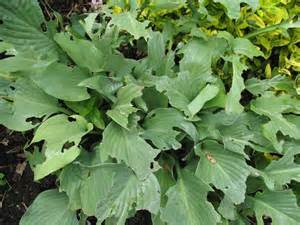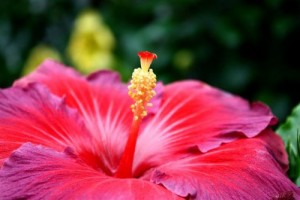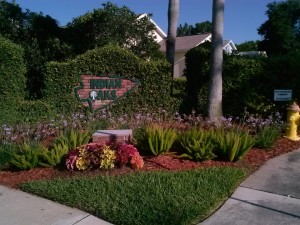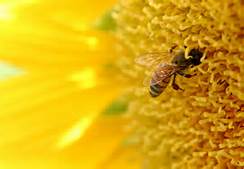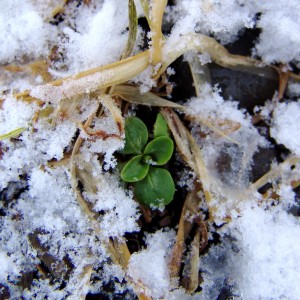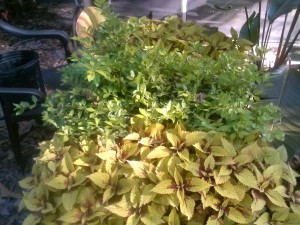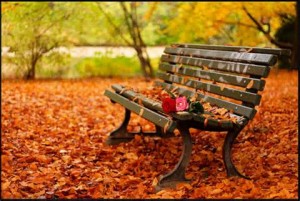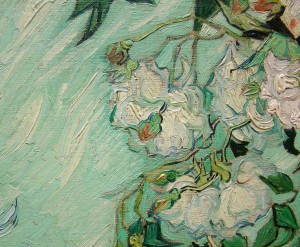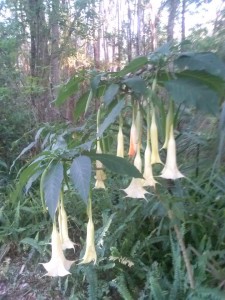But, I found these cool pots today at Lowe's on N. Dale Mabry today, love the color and they are a decent size, with nice enough room to make a small statement... a little centerpiece plant, with a few small plants, cascading perhaps. It's a nice pot or planter, at a fair price. Com'on folks, let's get busy planting! You can do this, it's worth your effort! Let's do it!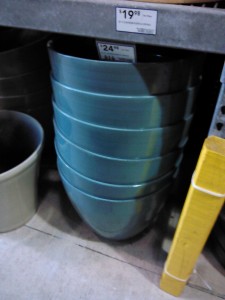
Slugs and Snails: Organic Pest Control
Slugs and snails can be a significant pest problem on many varieties of landscape and vegetable plants in Florida. As they mostly feed at night, they can be difficult to detect, but the damage that they leave behind should be evidence enough. While some other insects, such as caterpillars and grasshoppers, leave similar damage patterns, those critters can usually been seen during the day making the pest diagnosis easier.
So, how can you be sure that the damage to your plants is being caused by slugs and snails? You can set a trap for them! Slugs and snails like to spend their daylight hours in a cool, dank place, so you can make that easier for them by creating a place for them to go to! Position a large flat rock or similar type of object at the base of the plants that are being fed upon, and then check under it daily, in the cool of the morning. You will see them resting under the rock, thereby confirming that you have a slug or snail problem. As well, you can sometimes see their slime trails on concrete or leaf surfaces, which is also clear evidence.
So, once you have identified that you have a slug and snail problem, you will need to find a way to get rid of them. Slugs and snails can be difficult to eradicate, but with determination and persistence, you can control them. One way, or course, is to apply a commercial slug and snail bait product available at garden centers, but it can be costly and may have to be applied often, depending upon the weather. Another way to eliminate the problem is to change out your landscape and garden plants to a variety that is less favorable to them, as they do have their favorite host plants such as Hosta and Peace Lily.
Fortunately, there are some other options to control slugs and snails, that are not only organic, but also fun and clever. Any of these following methods will work, but you may want to incorporate all of them in your pest control program:
- Remember the flat rock that we used earlier to help identify the presence of slugs and snails? Add a few more of those to the garden and then check under them daily, preferably in the morning. Physically remove the snails, bag them up, and throw them away!
- Beer. That's right, slugs and snails love beer! Dig a shallow hole in the ground near the plants that are being fed upon, and place an empty plastic butter tub or similar in the hole, so that the container is flush with the surrounding soil. Fill the tub half way with beer, and then wait. Slugs and snails love beer, and will fall into the tub at night and drown. Empty the tub every few days as needed, and fill again. Continue repeating this program until the population is eventually reduced, when you aren't trapping any more pests.
- Add copper banding to the base of you plants. Slugs and snails hate copper, as it is believed that it gives them an electrical charge. This method is more practical as a physical barrier at the base of a plant, or as a copper strip added to the lip of a potted plant, or similar concept. As well, you may have heard that you can use pennies, but that is not true today, as pennies no longer have copper added to them.
By now, you may have realized that controlling slugs and snails in your garden may not be easy, but with a plan and some persistence, your efforts will pay off. By using these organic pest control methods in a mufti-faceted program, you will eventually be able to enjoy your favorite plants, free of slug and snail damage!
So, let's get slug and snail hunting folks!
Donell
Hibiscus: a Florida Landscape Favorite
Did you know that today is Pascua Florida Day, and is a state of Florida day of recognition? April 2nd is the anniversary of the discovery of Florida by Juan Ponce De Leon, in 1513. Ponce De Leon was a Spanish explorer, and named this newly discovered land after a celebration day in his homeland of Spain called Pascua Florida, meaning a feast of flowers. Other than the state flower Orange Blossom, there is no other plant that says Florida more than the Hibiscus, and, naturally, it is a Florida landscape favorite.
What better way to celebrate our Florida's naming day than to plant some Hibiscus in your landscape, brew some Hibiscus Tea, and bake some Hibiscus candy? Yes, that's right, Hibiscus is not only edible, but it is tasty as well! Beyond Hibiscus being a Florida landscape favorite for it's beautiful year-round flowers, it is renowned for it's natural medicinal properties, and well as unique flavor in teas and food.
Not only is Hibiscus a Florida landscape favorite, it is a world-wide favorite, too! It is commonly found in tropical and sub-tropical environments, and thrives best in temperate climates. It is the state flower of countries such as Malaysia and Haiti, and it's flower has unique symbolism that can be found in cultures such as India and Tahiti.
As a landscape plant, Hibiscus can be one of the easiest and most rewarding plants in your garden, providing endless beautiful blooms of vibrant colors. It prefers full sun for best blooming, but will tolerate partial shade, and once established, it is very drought tolerant. The Hibiscus can have some unique pest problems, though, such as aphids, Pink Hibiscus Mealy-bug, and Chilli Trips, that can be controlled with pesticides, if desired. The worst pest problems for Hibiscus, though, in my opinion, are deer and extreme cold. If you live in an area that is populated with deer, Hibiscus is a deer favorite, and will simply be a feeding station for them, and they will never bloom. As well, if your planting area is prone to repeated frost or freezing temperatures, an unprotected Hibiscus will not survive for long.
What the heck! Plant one Hibiscus, and give it plenty of room, as they they can grow rather large on some of the varieties (8' tall or better, and almost just as wide). And, when family and friends come for your annual summer tea party, dazzle them with your scrumptious Hibiscus candies, and delectable Hibiscus tea (I hear that it's even better with rum!).
Pick your favorite Hibiscus variety from these options: http://3seasonsgrowers.com/pb/wp_4a4e7cc3/wp_4a4e7cc3.html
Then, let's get the party started!
http://www.cupcakeproject.com/2010/08/hibiscus-tea-brewed-at-home-from-dried.html
http://www.cupcakeproject.com/2010/08/candied-flowers-hibiscus.html
Let's get Hibiscus-ing, Folks!
Donell
Adding Annual Flowers to Your Landscape
Adding annual flowers to your landscape is a great way to bring fabulous bursts of color to your garden, even though they are usually temporary. Annuals are seasonal plants, that are sometimes called bedding plants, and they are narrowly defined as plants that grow, and reproduce (which means to flower) and die, with a one year time frame. In the landscape world, then, when they are flowering, they are at the peak of their life when you buy them, and will only live for a few more months, in your garden. Most annual plants are designed to live for 3 or 4 months after purchase, with the expectation that they will be replaced out, seasonally, with another annual of a different type, that prefers the new season. With that in mind, adding annuals to your landscape can bring a wonderful pop of color, seasonally, with an expected rotation of changing them out 3-4 times a year, given their limited lifespan and preferred season.
Adding annuals to your landscape can bring a wonderful and changing variation to the look of your landscape, but it is not for everyone. While some annuals can be low maintenance and seem to free-seed and live on their own, others can require dead-heading of old seed pods and pinching back when they get leggy and spindly. More so, most annuals have a preferred season, and do require a rotational change-out. However, if you are willing to do the work, no matter how large or small the designated area for planting, you will rarely find the colors to add to your landscape, that annuals can bring. They bring vibrant colors in a big way on a small scale, that no other plant can do!
If you do decide to add annuals to your landscape, here are a few tips:
- Annuals always will need a bed of fresh potting soil to be planted in. Do not plant them in regular Florida soils and expect success.
- If you want to mulch your annual bed, do not mulch the annual. Leave a 1" clearance around the stem of annuals, and only lightly mulch the soil bed, as most annuals are very sensitive to materials around their stems and can die from root rot or too-deeply planting.
- Know the preferred season for your annuals. Many nurseries and almost all box stores sell annuals (and vegetables) out of season. A smart man told me recently that he simply watches for what annuals are planted at the subdivision entrances and commercial buildings, and he follows suit. He is absolutely right and this is an awesome way to get it right the first time. The pros are not guessing about the right season/ right annual.
- Some annuals are more prone to insect and fungal problems, so if you opt to select those plants that are, stay vigilant with your pest control, for ultimate success.
- Lastly, as always, have fun with your landscaping and don't give up! I don't believe in black thumbs, and some plants just have rules or natures that have to be followed. Follow them! and you will be successful.
As a note, and as a landscaper, I do not install many annual beds, but when I do, this is my philosophy:
- Keep the bed small, within 1-2 trays of plants, always in a bed of potting soil
- I prefer a 3 time a year rotation: Begonias in the spring, as they can handle the heat, but hate the rain; Coleus in the mid-summer as they love the rain and the heat; Petunias in the winter, as they can handle some heat but love the cold.
There is so much to know about gardening and landscaping, and IFAS is the source. For more information about annuals, and seasonal tables, click on this link:
http://edis.ifas.ufl.edu/mg319
Let's get gardening, Folks!
Donell
Welcome, Spring!
Today is the first day of Spring! Please, enjoy this beautiful Ode to Spring, by Elizabeth Bentley:
Elizabeth Bentley
Ode To Spring
WELCOME, sweet season of delight,
What beauties charm the wond'ring sight
In thy enchanting reign!
How fresh descends the morning dew,
Whilst op'ning flow'rs of various hue
Bedeck the sprightly plain.
The artless warblers of the grove
Again unite in songs of love,
To bless thy kind return:
But first the lark, who roaring seems
To hail the orb of day, whose beams
With fresh refulgence burn.
The limpid brook that purls along,
The tuneful blackbird's joyous song,
The softly-whisp'ring breeze;
The mossy hills, which now invite,
These with the verdant meads unite,
Th' elated mind to please.
The mind with thoughts of good possest,
With innocence and virtue blest,
Untaught in vice's ways;
May taste those joys by nature giv'n,
May lift th' enraptur'd eye to heav'n,
And their great Author praise.
Stern Winter's gloomy season past,
We see fair Spring advances fast,
With Summer in the rear;
Soon Autumn's shades will interpose,
And a succeeding Winter close
The swift-revolving year.
Of human life an emblem true,
The early morn of youth we view,
In Spring's delightful face;
Meridian life's a Summer's day,
With Autumn fades; its quick decay,
In winter's blast we trace.
Then let us prize each fleeting hour,
Improve the moments in our pow'r,
E'er time shall cease to be;
Then shall our spirits, taking wing,
Be crown'd with an eternal Spring,
From Wint'ry storms set free.
The Day before Spring Begins
Spring is here, and has been here in Tampa, for the last few weeks. Tomorrow, though, is officially the first day of Spring. Of course, we welcome it, even though we had a relatively mild winter, as our gardening and outdoor activities can begin in earnest.
Our friends and family members up north, though, have not been as similarly blessed. For them, Spring still feels weeks away, and I suppose it is. To show our compassion and solidarity, I have this ode to spring, to share with all:
Ode To Spring
It snowed today
Again
Like yesterday
And once more
Snow tomorrow
A harsh winter
That's what they say
Colder than it's ever been
Snow like we've never seen
Spring... it will be late
But I will wait, for like fate
Spring always follows
Spring always comes
Spring has never failed me
Even under 6 feet of sorrow
No matter how long I burrow
Spring somehow always finds me
Happy St. Patrick’s Day!
St. Patrick's Day is the day that we show off our green! We wear green, we drink green beer, and we eat cabbage....and we write Limericks to celebrate Ireland, also know as the Emerald Isle! So, we should be talking about plants with Emerald green leaves, but instead, I am going to talk about plants with Lime foliage, my little twist on "Lime-rick"! I know, it's a stretch, but what better day to talk about plants that bring something different to the garden?
When designing your landscape, you can add interest to the final plan by including plants with varying textures, flowers, mature height, and foliage color. There are an endless number of plants that have various hues of green, all the way from a dark emerald green to almost a bluish-silver hue. And, surprisingly, there are a handful of plants that offer a shade of lime green that will make your landscape pop, especially when paired with other plants that help them stand out and shine.
If you are considering adding some lime green foliage plants to your landscape design, be sure to place them next to plants that will highlight their uniqueness. Lime green foliage can really pop when planted next to dark greens, reds, and oranges. Conversely, it can be lost or washed out when planted next to a white or yellow house paint, or white and light colored green foliage plants. If you are uncertain as to what will work in your plant combinations, try a few pairings at your local nursery before making your final selections. Ultimately, you want all of your plants in your design to compliment each other, to bring out the best features of each individual plant. As always, half of the fun of gardening is experimenting, and going bold can bring a delightful result!
Considered any of these lime green foliage plants to add to your landscape. All of them are low maintenance and easy care plants for our Tampa landscapes:
- Foxtail Fern, added bonus of unique texture
- Coleus, available in many varying leaf colors with limes, yellows, and reds (in picture above)
- Potato Vine
- Gold Mound Duranta (in picture above, with Coleus)
- Ti Plants, either Kiwi or Lemon-Lime varieties
So, let's get growing, Folks! This St. Patrick's Day, let's really show of our greens.....with Lime greens! You just can't go wrong, and you will be bringing something new to table, so to speak!
Donell
Creating a Memorial Garden
It is in our nature to commemorate the passing of our loved ones, and we do it in many different ways. Not only do we want to share our love, respect, and reverence for those that we have lost, we want to remember them, and to be reminded of their past presence and impact that they have had on our lives. One way to do that is to memorialize them through landscaping and landscaping concepts. It is a lot easier than you may think.
Memorializing a passed loved one can be as simple as planting a tree in their name at a local church or county park, to adding a bench by a lake in your community. You can even have a small stone engraved and set on a public wall, or take the same stone and cast it into the river at a place that you both loved. You can even create a garden at your home, that will not only add to your existing landscape, but can also create a warm and comforting space for you, family and loved ones to reflect and remember your lost loved one.
A memorial garden is not intended to be a sanctuary for the dead, but instead, a living, vibrant remembrance for the living to reflect upon the life and love and presence of those that have passed. With that in mind, I suggest that the design of the garden should be driven towards the desires of the living, with a few touches of the personality of the deceased. It should be a place of comfort, that fills the senses of sight, sound, and smell, at least, and It should be a place of life, that commemorates the lives of those that are now gone.
The garden layout and design does not have to be grand or of large scale, it can simply be a courtyard, or a small patch of land, or even in pots on a balcony. It needs to incorporate flowers and plants that you love, that remind you or inspire you to reflect on your loved ones, both here and gone. Considered adding flowers that attract butterflies, or have scent, or unique foliage that glisten by either sunlight or moonlight, or whistle in the wind. Add whimsy to your memorial garden with statues, glass globes, chimes, decorative pots, bird baths, benches, and more. Tailor your memorial landscape design to your unique tastes, and for those that you are memorializing. A memorial garden is unique to only you, and it should reflect that.
As always, Let's get gardening, Folks!
Donell
Rose Gardens for World Peace
Roses have been an important part of mankind's psyche and cultural mores since time memorial. Throughout various ages, the Rose has symbolized many things to many societies, but almost universally it represented the emotions of love, peace, harmony, and unity. Even today, the Rose remains a strong representative of mankind's better virtues, and the language of a Rose still speaks volumes, without a spoken word, through it's simple yet powerful symbolism.
Roses, and in particular the various colors of Roses, have come to represent the following sentiments:
- Red: deep passionate love, romance, romantic love, sacrifice
- Pink: grace and elegance, appreciation, enduring love that is not passionate or romantic
- Yellow: warmth, happiness, joy, friendship
- White: innocence, purity, peace, unity, remembrance
There is no better example of using Roses to exemplify their timeless symbolism for mankind than in the International World Peace Rose Gardens. They are found in five major cities in the world: Sacramento, Pacific Palisades CA, Mexico City, Assisi Italy, and Atlanta (the M.L. King Jr. National Historic Site). Each garden has a specific theme that is dedicated to a concept or movement towards world peace (Atlanta's theme is "I have a Dream"). Each garden uses design and roses and color to create a message of peace, world unity, and understanding amongst us all. In fact, their mission statement is "to advance peace and understanding amongst all the nations, cultures and religions of the world through the creation of rose gardens that become magnets for community activities". It is a beautiful concept, worthy of the Rose itself.
To learn more, click here:
http://worldpeacerosegardens.org/
Scented Plants for a Fragrant Garden
A well designed landscape attempts to stimulate our five senses of sight, smell, touch, sound, and taste. With that in mind, adding scented plants to create a fragrant garden can be the most surprising and rewarding of all garden design, by tickling our sense of smell.
Some plants, such as Gardenia and Roses, are universally known for their beautiful fragrance, and are added to gardens for just that reason. Others, such as Crinum Lily and Angel's Trumpet, are not as well known, but can bring as much pleasure as their better known garden mates. As well, most scented plants do not provide scent year-around, so to create a fragrant garden for almost all seasons, one must plant a variety of scented plants. With that, not only will your landscape be diverse in scent and texture (touch), you will also have the added benefit of flowers (sight) and possibly taste (with herbs, like Rosemary and Mint). As an added bonus, plants like Loquat, Citrus, and Magnolia provide a food source for birds and wildlife (sound), after their scented flowers have passed. Why, one might even say that the beginning of a full-senses garden experience begins with scented plants!
Selecting scented plants for a fragrant garden is easier than you think. As always, you must take into consideration the plants preferred planting sight (sun, soil, etc.) as well as it's size at maturity, and then simply begin adding them to your current landscape. Alternatively, you can build and design your landscape around scented plants, selecting ones that bloom in different seasons. As always, half the fun in gardening is experimenting, so just enjoy the process and no doubt, you will be amply rewarded!
Any of these easy-care scented plants would make a wonderful addition to your fragrant garden:
- Carolina Yellow Jasmine
- Sumbac a/k/a Arabian Jasmine
- Confederate Jasmine
- Night Blooming Jasmine
- Star Jasmine
- Anise
- Loquat
- Magnolia
- Citrus, all varieties
- Crinum Lily
- Angel's Trumpet
- Roses, not all varieties
- Society Garlic (not pleasant smelling to all)
- Butterfly Ginger
- Tea Olive
- Rosemary and many other herbs
- Gardenia
All of the plants listed above are well-suited for Tampa landscapes (zone 9) and are generally drought tolerant and low maintenance. As well, some of them provide a heavy scent, while others, a more light and subtle fragrance, providing an opportunity for all gardener's to find the perfect plant, to tickle their senses!
Let's Get Growing, Folks!
Donell

